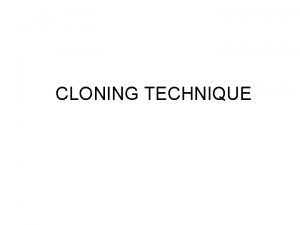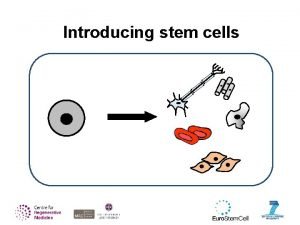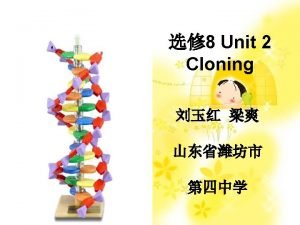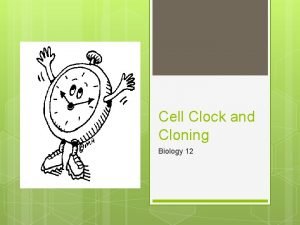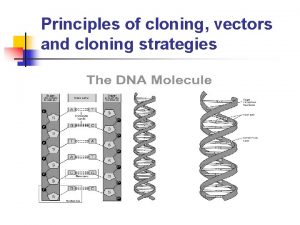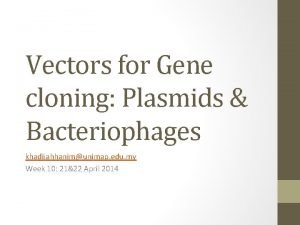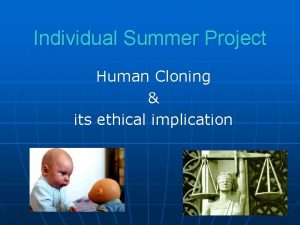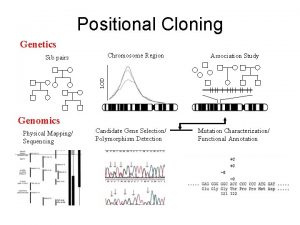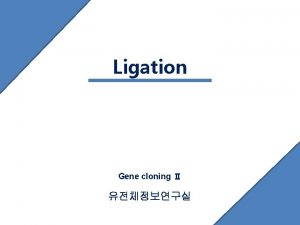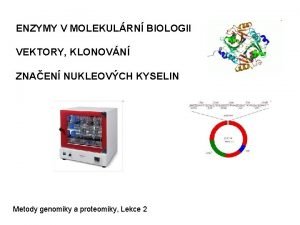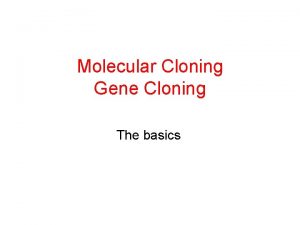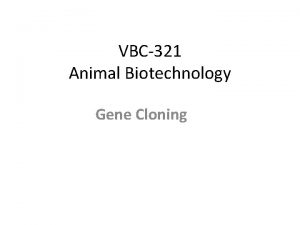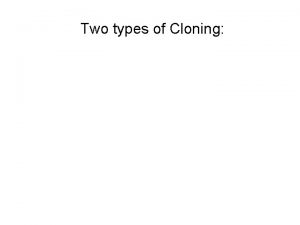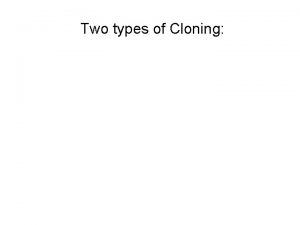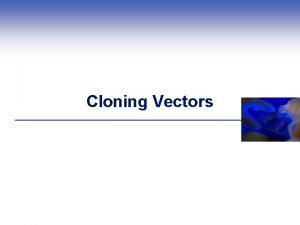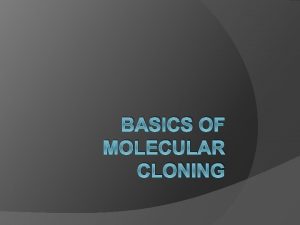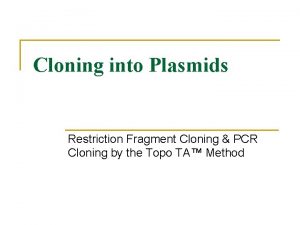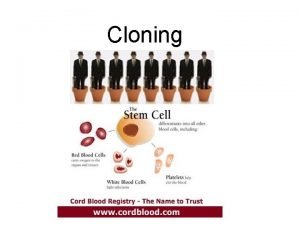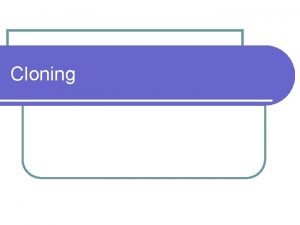Cloning Reproductive cloning vs Therapeutic cloning What is















- Slides: 15

Cloning. Reproductive cloning vs. Therapeutic cloning

What is a clone? It is a precise genetic copy Have you heard of Dolly?

Dolly, the sheep (Reproductive Clone) First cloned mammal Born: 5 July 1996 Birthplace: Edinburgh, Scotland Died: 14 February 2003 (euthanization) Cells from the udder of a pregnant six year-old sheep were inserted into the uterus of another sheep to develop, and Dolly was born. Dolly had the DNA of her source, making her the first mammal successfully cloned using adult cells. Dolly was put to sleep in 2003 after doctors detected progressive lung disease, though she had only reached half the life span of a typical sheep.

Dolly’s procedure = SCNT Somatic An Cell Nuclear Transfer (SCNT) unfertilized egg from a female animal (oocyte) has its nucleus removed (enucleated). The nucleus of a single somatic cell (nonreproductive cell) is inserted into the enucleated oocyte. The reproductive machinery in the oocyte reprograms the genetic material of the somatic cell (reconstituted embryo) Reconstituted embryo is placed into the uterus of a surrogate female and she brings it to term and births the animal

Obstacles to reproductive cloning Success rate for producing a live newborn using SCNT is low (~ 3/100) Many problems occur in fetal development; scientists still researching why “Large offspring syndrome” at birth: they are born 20 -30% larger than usual making delivery difficult. Unusual health problems after birth occurring early in the maturation to adulthood.

Therapeutic Cloning Includes all the stages of reproductive cloning except that the embryo is not implanted into a surrogate but instead is allowed to undergo cell division for several days in the lab until it reaches the blastocyte stage. The blastocyte is then opened and the stem cells (inner cell mass) are placed in tissue culture and copy themselves forming clones

Stem Cells: two main types A recently fertilized human egg is totipotent (its potential to become any type cell is total). Example: natural clones-identical twins 1. 2. Embryonic (pluripotent) stem cells occur after 4 days of cell division. The have the potential to become many types of cells. After this stage, they mature into adult stem cells. Adult (multipotent) adult stem cells: found in small amounts in the body but most accessible in the bone marrow. They give rise to specific cells only.

SCNT used in both reproductive and therapeutic cloning The cloning intent/purpose differs: Reproductive cloning: is to produce a new organism, animal or human being (deemed by scientists and society to be unsafe). Therapeutic cloning: is to create embryonic stem cells that are genetically compatible with the recipient (many scientists favor this because of its application in disease treatments).


Therapeutic potential of stem cells Real advantage of stem cells – permits the production of perfect-match tissue Scientists have found that embryonic stem cells pick up cues from neighboring cells and can differentiate into that cell type Scientists hope stem cells will be used to treat heart disease, Parkinson’s disease, other disorders of the nervous system

Debate over stem cells Scientists state that creating embryonic stem cells using SCNT does not really destroy embryos produced by the fusion of the egg and sperm. They state that this method uses an unfertilized egg with its nucleus removed and fuses with genetic material from an adult’s body. Opponents say that this fusion has the potential to become a living thing if transplanted into the uterus of a female.

Regulatory oversight Human stem cell research 2001 legislation allowed federal funding of research using 64 existing human embryonic stem cells. The legislation declared no federal funds for additional research. 2009 Obama has overturned this in his first year of office allowing funding for new lines of stem cells

Currently, the federal government does not explicitly prohibit SCNT. The Food and Drug Administration has stated that human reproductive cloning would be unlawful unless an application were first submitted to the agency. FDA also would need to approve the clinical use of any therapies derived from SCNT research before they were administered to humans.

Public opinions Animal testing: 59% of Americans feel it is morally acceptable. Fur clothing: 60 % of Americans feel it is morally acceptable. Cloning animals: 63% of Americans feel it is morally wrong. Human Cloning: 88% of Americans feel it is morally wrong. The use of human embryonic stem cells: 59% of Americans feel it is morally acceptable.

Now you have facts, what is your opinion?
 Reproductive vs therapeutic cloning
Reproductive vs therapeutic cloning Reproductive cloning
Reproductive cloning Advantages of cloning
Advantages of cloning Cloning in nature
Cloning in nature Cosmid vector slideshare
Cosmid vector slideshare What is cloning
What is cloning Clock gate cloning
Clock gate cloning Cloning dangers
Cloning dangers M13 phage vector
M13 phage vector Clonaid
Clonaid Cloning and sequencing explorer series
Cloning and sequencing explorer series Positional cloning
Positional cloning Gene cloning
Gene cloning Nick translation
Nick translation Steps in molecular cloning
Steps in molecular cloning Plasmid
Plasmid
